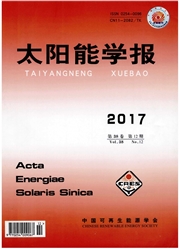

 中文摘要:
中文摘要:
针对内部结构复杂的复合材料风力机叶片,基于等代设计法,对某3MW叶片进行复合材料初始铺层设计,建立完整的有限元参数化模型。基于修正的叶素动量理论和有限元法,提出一种全新的风力机叶片气动弹性耦合分析方法。将该方法与改进的遗传算法结合,以叶片质量最小和扭转变形最小为优化目标,以复合材料单层厚度、主梁位置等作为优化设计变量,建立叶片的优化设计模型,并进行优化设计。优化结果表明,相比初始叶片,优化叶片的质量有较大的减小,同时可减小叶片的扭振变形量,提高叶片在气动弹性影响下的功率。该研究对于风力机叶片的气动结构一体化设计具有重的指导意义。
 英文摘要:
英文摘要:
The complex internal structure of composite ply for a 3MW wind turbine blade was designed based on modified genetic algorithm and finite element method. The finite element parametric model for the blade was first established. Based on the modified blade element momentum (BEM) theory and finite element method, a novel fluid structure interaction method with aeroelastic effect, which is capable of analyzing the influence of wind turbine performance caused by structural deformation of blade, was presented. The mathematical optimization model which minimizes the blade mass and torsion deformation was developed. Using the design variables of laminate thickness, beam thickness and so on, the original blade was optimized. The optimization results showed that compared to the initial blade, the mass of the optimized blade is reduced largely, and the torsion deformation is reduced at the same time. Consequently, the power with aeroelastic effect is improved. This study has important guiding significance for the structural optimization design of wind turbine blades.
 同期刊论文项目
同期刊论文项目
 同项目期刊论文
同项目期刊论文
 期刊信息
期刊信息
